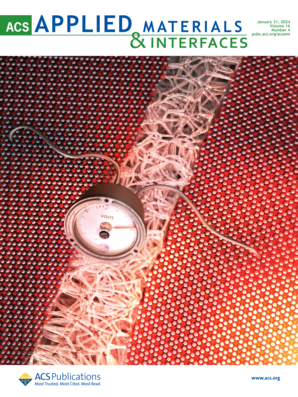Clickable Polymer-Based Coatings for Modulating the Interaction of Metal–Organic Framework Nanocrystals with Living Cells
IF 8.3
2区 材料科学
Q1 MATERIALS SCIENCE, MULTIDISCIPLINARY
引用次数: 0
Abstract
Nanosized microporous metal–organic-frameworks (NMOFs) serve as versatile drug delivery systems capable of navigating complex microenvironments and interacting with cells in specific tissues. The physicochemical properties of NMOFs, such as size, composition, porosity, colloidal stability, and external surface functionalization are essential for their success as efficient carriers. This study introduces a flexible, clickable coating using an amphiphilic polymer derivatized with dibenzo cyclooctyne groups as a universal, postsynthetic functionalization tool. To prove its universality, nanosized MOFs with different structure and composition (UiO-67, NU-1000, PCN-222, and ZIF-8) were produced with high monodispersity and were coated with a clickable, amphiphilic polymer. The resulting polymer-coated NMOFs display exceptional colloidal and structural stability in different biologically relevant media. For comparative purposes, we selected two size-equivalent NMOFs, ZIF-8 and UiO-67, which were functionalized with a library of biologically relevant azide-derivatized (macro)molecules, including poly(ethylene glycol), mannose, and a dynein-binding cell-penetrating peptide, using a bioorthogonal reaction. The choice of ZIF-8 and UiO-67, both 150 nm in size but with distinct coordination and surface chemistries, is pivotal due to their differing acid and base stability characteristics, which may potentially influence their performance in cellular environments. To track their performance in vitro, the NMOFs were loaded with cresyl violet, a common histological stain and lysosomal marker. Cellular internalization of the surface-functionalized NMOFs was markedly governed by their distinct (macro)molecule characteristics. This demonstrates that surface properties critically influence uptake efficiency, while also highlighting the versatility and effectiveness of the proposed coating strategy. In particular, the one functionalized with the dynein-binding peptide demonstrated a markedly higher rate of cellular internalization compared to other NMOFs. In contrast, derivatizations with mannose and poly(ethylene glycol) are associated with a substantial reduction in cellular uptake, suggesting stealth behavior. These results provide a bioorthogonal and versatile alternative for the external surface engineering of NMOFs, aiming to improve targeted drug delivery effectiveness.

可点击聚合物涂层用于调节金属-有机框架纳米晶体与活细胞的相互作用
纳米微孔金属有机框架(NMOFs)是一种多功能的药物传递系统,能够导航复杂的微环境并与特定组织中的细胞相互作用。NMOFs的物理化学性质,如尺寸、组成、孔隙度、胶体稳定性和外表面功能化是它们作为高效载体成功的关键。本研究介绍了一种柔性的、可点击的涂层,该涂层使用了一种由二苯并环烷基衍生的两亲性聚合物作为通用的合成后功能化工具。为了证明其普遍性,制备了具有不同结构和组成的纳米mof (UiO-67, NU-1000, PCN-222和ZIF-8),具有高单分散性,并涂有可点击的两亲性聚合物。所得到的聚合物包被NMOFs在不同的生物相关介质中表现出优异的胶体和结构稳定性。为了比较,我们选择了两个大小相等的NMOFs, ZIF-8和UiO-67,它们通过生物正交反应被一系列生物相关的叠氮化物衍生(大分子)分子库功能化,包括聚乙二醇、甘露糖和动力蛋白结合的细胞穿透肽。ZIF-8和UiO-67的尺寸都是150纳米,但具有不同的配位和表面化学性质,由于它们不同的酸碱稳定性特性,这可能会影响它们在细胞环境中的性能,因此选择ZIF-8和UiO-67至关重要。为了追踪它们在体外的表现,将NMOFs装载甲酚紫(一种常见的组织学染色剂和溶酶体标记物)。表面功能化NMOFs的细胞内化明显受其独特的(宏观)分子特性的支配。这表明表面性质对吸收效率有重要影响,同时也突出了所提出的涂层策略的多功能性和有效性。特别是,与其他NMOFs相比,具有动力蛋白结合肽功能化的NMOFs表现出明显更高的细胞内化率。相反,甘露糖和聚乙二醇的衍生化与细胞摄取的大幅减少有关,表明其具有隐身行为。这些结果为NMOFs的外表面工程提供了一种生物正交和通用的替代方案,旨在提高靶向给药效果。
本文章由计算机程序翻译,如有差异,请以英文原文为准。
求助全文
约1分钟内获得全文
求助全文
来源期刊

ACS Applied Materials & Interfaces
工程技术-材料科学:综合
CiteScore
16.00
自引率
6.30%
发文量
4978
审稿时长
1.8 months
期刊介绍:
ACS Applied Materials & Interfaces is a leading interdisciplinary journal that brings together chemists, engineers, physicists, and biologists to explore the development and utilization of newly-discovered materials and interfacial processes for specific applications. Our journal has experienced remarkable growth since its establishment in 2009, both in terms of the number of articles published and the impact of the research showcased. We are proud to foster a truly global community, with the majority of published articles originating from outside the United States, reflecting the rapid growth of applied research worldwide.
 求助内容:
求助内容: 应助结果提醒方式:
应助结果提醒方式:


